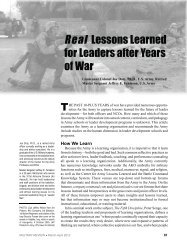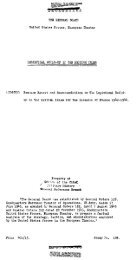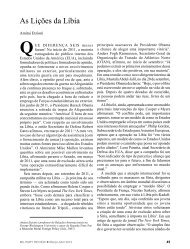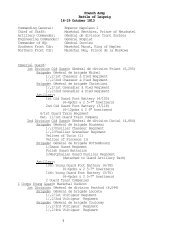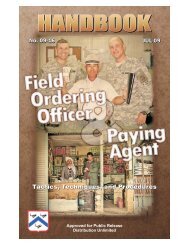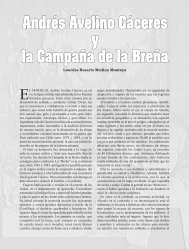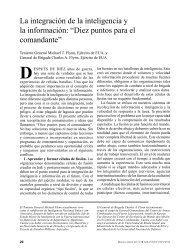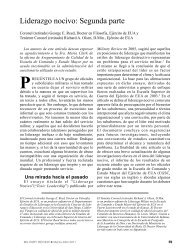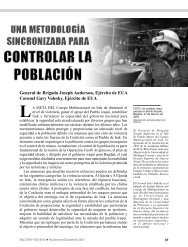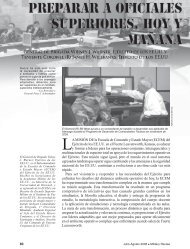Quartermaster Supply Operations - US Army Combined Arms Center ...
Quartermaster Supply Operations - US Army Combined Arms Center ...
Quartermaster Supply Operations - US Army Combined Arms Center ...
Create successful ePaper yourself
Turn your PDF publications into a flip-book with our unique Google optimized e-Paper software.
121. Storage.<br />
R-E-S-T-R-I-C -T-E-D<br />
a. The storage of' perishnbles in the United<br />
Kingdom wes handled almost entirely by the British Minietry<br />
of Food and by commercial agedcies under its control. On<br />
the continent there-was an extreme shortage of cold storage<br />
facilities, particularly auring the early stages of<br />
the invaslcn. This was due chiefly to the destructkn of<br />
cold storage plants by enemy and Allied action, and tc<br />
the inability to quickly rehabilitate the plants. Construction<br />
and rehabilitatiGn was undertfiken as smn as<br />
practicable but, until satisfactory facilities were obtain-<br />
able, reefer vans hauled perishables direct from the ships<br />
to the supply points. The use of reefer vans, however, due<br />
to the long haul, was not satisfacto y for the proper care<br />
and maintenance of perishable items. 5<br />
b. As the operations progressed, more and great-<br />
er facilities fcr cold storage became available. With<br />
the liberation of Paris (S-0040) cold.stcrage capacity<br />
became adequate for the first time.2<br />
c. Since fresh fruits and vegetables obtained<br />
from local sources were not normally received until ready<br />
for issue, little or no storage was required. Fresh fruit<br />
and vegetables rrom other sources were stored in clcsed<br />
warehouses, when available and if made necessary by weatner<br />
conditions. When closed storage was not available,the 'Yem<br />
atyle stacks 14 feet by 20 feet, wlth tarpaulin covers,<br />
were used.4,5 These stacks were generally the shape of<br />
a storage tent and easily put together. In some instances<br />
two or more of these stacks were joined together for better<br />
storage or for heating when neoessary. After the invasion<br />
was well under way, 90 percent of all perishables, other<br />
than refrigerated perishables, were stored inside. The<br />
Vrem stacks were used for the renaining ten percentV5<br />
d. There wa6 a limited amount of spcilage aong<br />
nonperishable items which were packed prior to late 1943.<br />
hnoisture, in gome cases, detariorated the shipping carton<br />
and caused cans to rust. Citrus juices Bometimes developed<br />
pin holing from the inaide due to the aoticn of the oftrio<br />
acid on the metal. There was also some lcos due to the<br />
deterioration and loss cf paper labels from the cans. The<br />
majority of thbse difficulties were corrected by the devel-<br />
opment and use of a moisture proof carton. Also, a new<br />
laminated asphalt craft bag was used for coffee, flour,<br />
sugar, salt, and driofl vegetables. This type of bag practically<br />
eliminated loss from stcrage and moisture. An<br />
inside lacquered can for citrus juices cllminated loss from<br />
pin holing, and the label defect was eliminate6 by pai ting<br />
or stenciling the contents on the outside of the cans. 9<br />
e. Approximately ten porcent of' the A or B<br />
ration compononts such as coffoc, flour, sugar and dried<br />
VGgEtableB were stored inside. All ogeraticnal rations,<br />
and the reEainlng compononts of the bulk rations, were<br />
stored outside in staoks and covered with tarpaulins. 5<br />
122. Distributicn.<br />
a, The inltial Class I supplies for the lnvasicn<br />
of mope were brought in by ferry craft such as landing<br />
craft. tank. and nmphiblous DUG'Ivs. After a sufficient<br />
- 80 -<br />
R-E -S 4'-R-I-C-T-E-D



